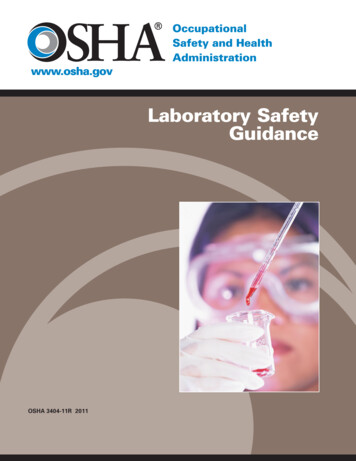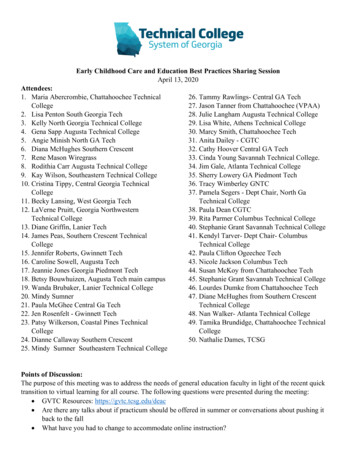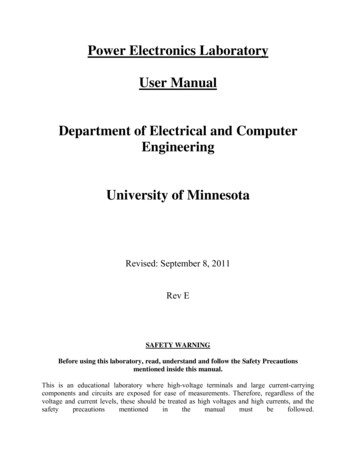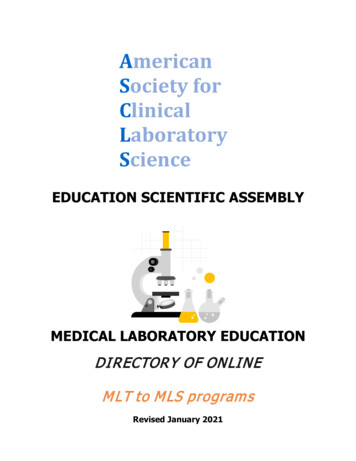
Transcription
FOOD SCIENCE ANDTECHNOLOGYLABORATORYSAFETYWORKBOOKPrepared by: Chandria Mitchell, 2011TABLE OF CONTENT
I. INTRODUCTIONII. DEFINITIONSIII. MICROBIOLOGY LABORATORY PRACTICESIV. SAFETY and PERSONAL PROTECTIVE EQUIPMENTV. EMERGENCY PROCEDURESA. Chemical SpillB. Biohazard SpillC. EvacuationVI. SIGNAGE AND LABELSVII. MICROSCOPE USAGE AND SAFETY
I. INTRODUCTIONVirginia Tech is committed to providing a safe and secure learningenvironment for students, particularly, in the laboratories.the responsibility of both instructors and students.Laboratory safety isBeing proactive in yourdesire to maintain a safe laboratory environment for all begins with prevention.Preventative measures include, understanding safety standards and hazards,appropriate laboratory conduct along with many other concepts.The purposeof this manual is to provide guidelines and references to help studentsdistinguish between good and bad laboratory practices.Microbiology is a challenging, but fun and rewarding course.Many ofyou plan to pursue a career in some aspect of food science, therefore thiscourse will assist in your future endeavors.Within the past several years thenecessity to ensure consumers a safe food supply has increased.the number of students studying food science has increased.As a result,Foodcontamination by microorganisms can occur at any stage of food production,therefore it is important for you, as a future food scientist, to be able tosuggest or conduct accurate microbiology tests to ensure food safety.Thiscourse will afford you this opportunity while teaching important procedures toprevent hazardous conditions in a laboratory setting.Knowledge of safety rules and equipment is the first component oflaboratory safety.Adhering to these rules is the second.causes of laboratory accidents each year.There are severalThe three most common are, 1)inappropriate use of chemicals and equipment, 2) inexperienced students,instructors and/or personnel and 3) inappropriate behavior or conduct.Persons that work or study in a microbiology lab will be required tohandle potentially infectious agents, therefore, the concepts presented are
imperative to your success.All microorganisms are potential pathogens, butproper handling (i.e. adhering to aseptic techniques, good laboratory practices)will reduce the likelihood of it becoming a health hazard.It is important tonote that none of Virginia Tech's microbiology lab courses perform experimentswith virulent pathogens.
II. DEFINITIONSTerms to help students understand microbiological concepts and laboratorysafety. Aseptic Technique- procedure performed under sterile conditions toeliminate contamination in hopes to obtain a pure culture of one type ofmicroorganism. Biohazard- biological organisms that are of potential harm or risk tohumans Disinfectant- the use of chemicals to destroy or inhibit the growth ofmicroorganisms that may cause disease or illness. Good Laboratory Practice (GLP)- a method employed in a laboratorysetting to prevent contamination, accidents and injuries. Media- a source of nutrient for the growth and reproduction of microbes. Microorganism- a tiny unicellular organism that includes, bacteria, viruses,fungi and protists. Pathogen- a disease or illness producing biological agent Personal Protective Equipment (PPE)- a barrier used to shield person(s)from potentially hazardous or hazardous biological, chemical or physicalagents. Spoilage organisms-microbes that cause physical changes, discoloration,and odors. Example microbes are bacteria and molds. Sterilization- the use of heat for the complete destruction or eliminationof all microorganisms. Ubiquity- microorganisms are everywhere Virulent- extremely infectious pathogen that causes disease
III. MICROBIOLOGY LABORATORY PRACTICESIt is important to follow the safety practices listed below to ensure safehandling of potentially pathogenic agents.1. Listen to the instructor at all times.2. Do not eat food, drink, chew gum or apply cosmetics.3. All chemicals have the capability to cause injury or illness.4. Read the lab manual or any other relevant material before class begins.5. No sandals, open-toed shoes, loose or baggy clothes and dangling jewelry.Long hair must be tied up.Anyone wearing inappropriate shoes will not bepermitted to enter the laboratory.6. Observe good housekeeping practices by maintaining an organizedworkstation and keeping the aisles clear of backpacks, etc.7. Work area/bench top must be immediately disinfected with ethanol or ableach solution before and after lab.8. Always wear laboratory goggles as instructed.9. Use disinfectant soap to wash your hands when you enter laboratory andthen before you leave.10. Work area/bench top must be immediately disinfected with ethanol or ableach solution before and after lab.11. Remove lab coats prior to exiting lab and entering non-laboratory areas.12. Exercise care and discretion when using media, microorganisms, reagentsand other chemicals13. Label all materials to include petri dishes, test tubes, reagents, media,chemicals, etc with your name, date, type of media, organism and any otherrelevent information.14. Never pipet chemicals, reagents or broth cultures with your mouth.
15. If the bunsen burner is lit never reach across it.Do not leave the burnerunattended.16. Never use your hands to pick up broken glass; use a broom and dustpan.Dispose of broken glass in the broken glass container.17. Never walk around with transfer loops, needles and wires that have not beenflame sterilized.18. Petri dishes are to remain closed until necessary.19. Close solution, reagent bottles and bacterial cultures when not in use.
IV. SAFETY and PERSONAL PROTECTIVE EQUIPMENTFamiliarize yourself with the location and operation of the following equipment.Safety EquipmentEyewash stationFire extinguisherFire blanketEmergency ShowerDrench hoseFirst Aid KitBroken Glass ContainerSharps BoxBiohazard Waste ReceptacleExitsSpill KitPersonal Protective Equipment (PPE)GlovesSafety GogglesFace Mask or ShieldLab Coat
V. EMERGENCY PROCEDURESIn case of an emergency notify your instructor IMMEDIATELY!A. Chemical Spill1. Notify your instructor and classmates immediately.2. Determine if anyone has been affected by the chemical. (i.e. allergic reaction)3. Make instructor aware of any injured classmate(s).theIf a chemical splashes onskin or clothing lead the student to the emergency shower.If thechemical splashes in the eyes lead them to the eye wash station or drenchhose.Remember to flush the affected area for 15 minutes.4. The instructor will then follow-up with additional instructions.B. Biohazard Spill1. Notify your instructor and classmates immediately.2. Cover the spill with a paper towel or cloth.3. Pour fresh 10% bleach solution or an appropriate disinfectant agent on thespill starting from the inside out.4. Let the spill sit for about 30 minutes.5. If there is broken glass use a dustpan and broom to pick-up it up.of the glass in the broken glass container.DisposeIn the event that the material is asharp dispose of it in the biohazard sharps container.6. Clean the area with disinfectant and dispose of contaminated material in ahazardous waste bin.C. Evacuation
1. Evacuation procedures are specific to each building and laboratory.Yourinstructor will discuss with you the procedures.VI. SIGNAGE AND LABELSObserve the safety signage located at the entrance and inside the laboratory.It is important for you to acknowledge and abide by the information indicatedon the sign. Many chemicals and reagents used in the laboratory are labeledaccording to its hazard level.Biohazard SignCorrosiveFlammableToxic ChemicalsNo Food or DrinkcHand wash StationChemical Hazards
VII. MICROSCOPE USAGE AND SAFETYYou are expected to handle each microscopewith the utmost care. Certain laboratoryexercises will require you to prepare bacterial slides,therefore, it is important to know how to properly cleanslides. Procedures like this help to preventcontamination and ensure laboratory safety.Materials required for microscope usage and safety include, microscope slides,cover slips, immersion oil, lens paper, lens cleaner, cleaning solution (70%ethanol or 10% bleach solution)Microscope Rules1. Always use both hands to carry a microscope. One hand goes on thehandle and the other on the base. Do not carry your microscope with onehand!2. Lens paper is the only material that should be used to clean the lens.Anything else will scratch it.3. After using immersion oil lens paper and cleaner should be used to wipe theobjective lens.4. Remove slides from the stage before returning the microscope to the cabinet.5. Never drag the microscope across the bench top. Instead, step away fromthe lens to allow your instructor or classmate to see what is in the field ofview.Slide DisposalTo prevent the contamination of microscopes and surrounding areas cleanand/or dispose of used slides in one of the following manners,1. Directly after use clean slides with 70% ethanol and wipe with lens paper,or2. Directly after use place slides in a fresh 10% bleach solution.
appropriate laboratory conduct along with many other concepts. The purpose of this manual is to provide guidelines and references to help students distinguish between good and bad laboratory practices. Microbiology is a challenging, but fun and rewarding course. Many of you plan to pursu










